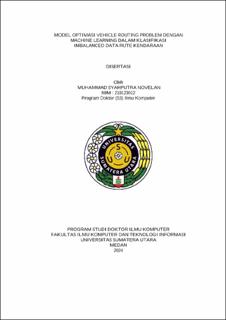| dc.description.abstract | The problem of imbalance in the process of vehicle route classification has become a challenge in the classification process and attracted the attention of a number of researchers. Industrial and service problems that are classified as combinatorial optimization include the vehicle routing problem. The research will formulate the relationship between the level of complexity of the vehicle routing problem, expressed in the number of problem 'nodes', with the value of the solution obtained and the computation time. Therefore, combinatorial vehicle routing problem optimization with machine learning is needed to optimize the total distance, and total travel time in the vehicle route of the goods delivery distribution line. The results of the vehicle routing problem optimization research method solve the combinatorial quickly by applying a model to limit the number of goods distribution transports. This optimization model can solve optimization problems efficiently, with the right time and with the best solution as seen in the results of testing the vehicle routing problem model with machine learning. Research results with machine learning models and vehicle routing problems with testing values K = 7, K = 9, K = 11. Where has a total time of K = 7 total time 58,624 seconds and K = 9 total time 47,231 seconds and K = 11 total time 57,365 seconds. From the test results with odd K values have better accuracy and the value of K = 9 is better with a percentage of 47,231 seconds compared to K = 7, K = 11. This research can be developed in solving combinatorial optimization with several types of vehicle routing problems by testing and proving. In solving other optimization machine learning approaches, it is necessary to consider the complexity of the problem, the input scale, the input structure and the time to solve the problem. | en_US |


